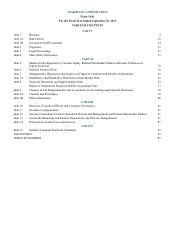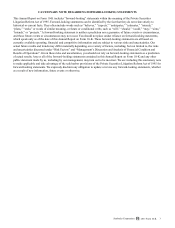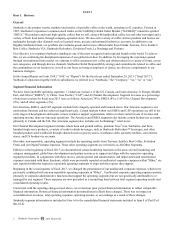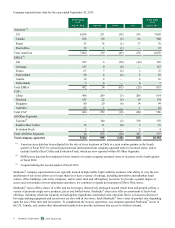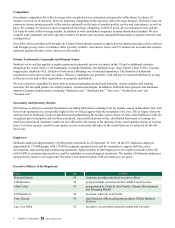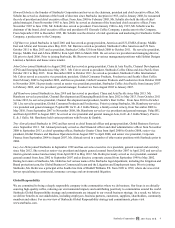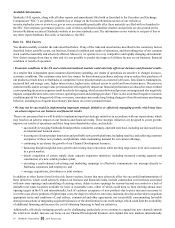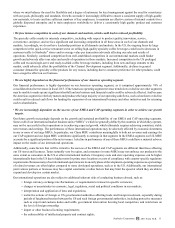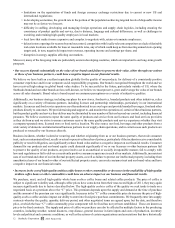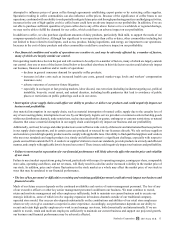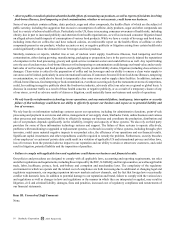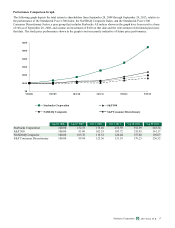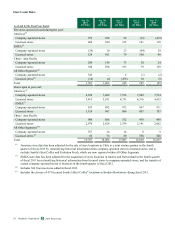Starbucks 2013 Annual Report Download - page 18
Download and view the complete annual report
Please find page 18 of the 2013 Starbucks annual report below. You can navigate through the pages in the report by either clicking on the pages listed below, or by using the keyword search tool below to find specific information within the annual report.
10
Available Information
Starbucks 10-K reports, along with all other reports and amendments filed with or furnished to the Securities and Exchange
Commission (“SEC”), are publicly available free of charge on the Investor Relations section of our website at
investor.starbucks.com or at www.sec.gov as soon as reasonably practicable after these materials are filed with or furnished to
the SEC. Our corporate governance policies, code of ethics and Board committee charters and policies are also posted on the
Investor Relations section of Starbucks website at investor.starbucks.com. The information on our website is not part of this or
any other report Starbucks files with, or furnishes to, the SEC.
Item 1A. Risk Factors
You should carefully consider the risks described below. If any of the risks and uncertainties described in the cautionary factors
described below actually occurs, our business, financial condition and results of operations, and the trading price of our common
stock could be materially and adversely affected. Moreover, we operate in a very competitive and rapidly changing environment.
New factors emerge from time to time and it is not possible to predict the impact of all these factors on our business, financial
condition or results of operation.
• Economic conditions in the US and certain international markets could adversely affect our business and financial results.
As a retailer that is dependent upon consumer discretionary spending, our results of operations are sensitive to changes in macro-
economic conditions. Our customers may have less money for discretionary purchases and may stop or reduce their purchases of
our products or trade down to Starbucks or competitors' lower priced products as a result of job losses, foreclosures, bankruptcies,
increased fuel and energy costs, higher interest rates, higher taxes, reduced access to credit and lower home prices. Decreases in
customer traffic and/or average value per transaction will negatively impact our financial performance as reduced revenues without
a corresponding decrease in expenses result in sales de-leveraging, which creates downward pressure on margins and also negatively
impacts comparable store sales, net revenues, operating income and earnings per share. There is also a risk that if negative economic
conditions persist for a long period of time or worsen, consumers may make long-lasting changes to their discretionary purchasing
behavior, including less frequent discretionary purchases on a more permanent basis.
• We may not be successful in implementing important strategic initiatives or effectively managing growth, which may have
an adverse impact on our business and financial results.
There is no assurance that we will be able to implement important strategic initiatives in accordance with our expectations, which
may result in an adverse impact on our business and financial results. These strategic initiatives are designed to create growth,
improve our results of operations and drive long-term shareholder value, and include:
• successfully leveraging Starbucks brand portfolio outside the company-operated store base, including our increased focus
on international licensed stores;
• focusing on relevant product innovation and profitable new growth platforms, including retail tea, and achieving customer
acceptance of these new products and platforms while maintaining demand for our current offerings;
• continuing to accelerate the growth of our Channel Development business;
• balancing disciplined global store growth and existing store renovation while meeting target store-level unit economics
in a given market;
• timely completion of certain supply chain capacity expansion initiatives, including increased roasting capacity and
construction of a new soluble products plant;
• executing a multi-channel advertising and marketing campaign to effectively communicate our message directly to
Starbucks consumers and employees; and
• strategic acquisitions, divestitures or joint ventures.
In addition to other factors listed in this risk factors section, factors that may adversely affect the successful implementation of
these initiatives, which could adversely impact our business and financial results, include construction cost increases associated
with new store openings and remodeling of existing stores; delays in store openings for reasons beyond our control or a lack of
desirable real estate locations available for lease at reasonable rates, either of which could keep us from meeting annual store
opening targets in the US and internationally; lack of customer acceptance of new products due to price increases necessary to
cover the costs of new products or higher input costs; the degree to which we enter into, maintain, develop and are able to negotiate
appropriate terms and conditions of, and enforce, commercial and other agreements; not successfully consummating favorable
strategic transactions or integrating acquired businesses; or the deterioration in our credit ratings, which could limit the availability
of additional financing and increase the cost of obtaining financing to fund our initiatives.
Additionally, effectively managing growth can be challenging, particularly as we continue to expand into new channels outside
the retail store model, increase our focus on our Channel Development business, and expand into new markets internationally
2013 10-K
Starbucks Corporation Form


